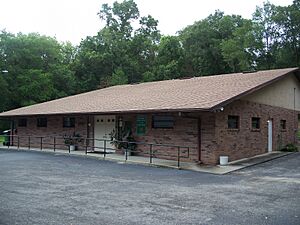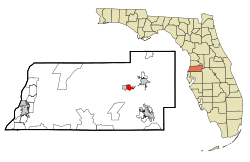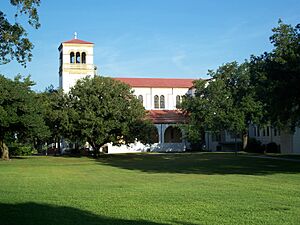St. Leo, Florida facts for kids
Quick facts for kids
St. Leo, Florida
|
|
|---|---|
| Town of St. Leo | |

Town hall
|
|

Location in Pasco County and the state of Florida
|
|
| Country | United States |
| State | Florida |
| County | Pasco |
| Settled | 1881 |
| Incorporated | June 4, 1891 |
| Government | |
| • Type | Mayor–Commission |
| Area | |
| • Total | 1.30 sq mi (3.37 km2) |
| • Land | 1.12 sq mi (2.91 km2) |
| • Water | 0.18 sq mi (0.46 km2) |
| Elevation | 187 ft (57 m) |
| Population
(2020)
|
|
| • Total | 2,362 |
| • Density | 2,103.29/sq mi (811.92/km2) |
| Time zone | UTC-5 (Eastern (EST)) |
| • Summer (DST) | UTC-4 (EDT) |
| ZIP code |
33574
|
| FIPS code | 12-62775 |
| GNIS feature ID | 0290265 |
| Website | http://www.townofstleo.org |
St. Leo is a small town located in Pasco County, Florida, in the United States. It's part of the larger Tampa Bay area, which includes cities like Tampa and St. Petersburg. St. Leo is famous for being home to St. Leo University, Holy Name Monastery, and St. Leo Abbey.
In 2020, the town had a population of 2,362 people. The current mayor of St. Leo is Vincent D'Ambrosio, who was elected in 2022.
Contents
History of St. Leo
St. Leo began to form in 1881. In 1889, a group of Benedictines (a type of Christian monks) started a monastery called St. Leo Abbey and a school called St. Leo College. They built these on land that used to belong to Judge Edmund F. Dunne. This land was located east of San Antonio, Florida, near Lake Jovita. The area was later officially made into a town called St. Leo.
Judge Dunne was a lawyer involved in a big land deal in Florida in 1881. As part of his payment, he received a large amount of land, about 100,000 acres. In 1882, he chose the area around Lake Jovita for his land. He named the lake after St. Jovita.
Judge Dunne first started a Catholic community called San Antonio in 1882. He also created other small villages nearby, like Saint Joseph and Villa Maria. Today, only the rural community of Saint Joseph is still around. The area that is now the Town of St. Leo got its name after the Benedictine monks arrived. The town's name comes from Pope Leo IX.
Geography and Location
St. Leo is located at coordinates 28°20′17″N 82°15′12″W.
The United States Census Bureau says that the town covers a total area of about 1.9 square miles (4.9 square kilometers). Most of this area, about 1.6 square miles (4.1 square kilometers), is land. The rest, about 0.3 square miles (0.8 square kilometers), is water, making up about 13.90% of the total area.
St. Leo is known for its gently rolling hills. The land here rises from about 100 feet to 180 feet above sea level.
Climate in St. Leo
The weather in St. Leo is usually hot and humid in the summer. Winters are generally mild. This type of weather is called a humid subtropical climate. It means the area gets plenty of rain and has warm temperatures for most of the year.
| Climate data for St. Leo, Florida, 1991–2020 normals, extremes 1895–present | |||||||||||||
|---|---|---|---|---|---|---|---|---|---|---|---|---|---|
| Month | Jan | Feb | Mar | Apr | May | Jun | Jul | Aug | Sep | Oct | Nov | Dec | Year |
| Record high °F (°C) | 89 (32) |
92 (33) |
95 (35) |
98 (37) |
101 (38) |
104 (40) |
102 (39) |
101 (38) |
101 (38) |
98 (37) |
96 (36) |
89 (32) |
104 (40) |
| Mean maximum °F (°C) | 82.6 (28.1) |
84.2 (29.0) |
86.9 (30.5) |
90.4 (32.4) |
94.5 (34.7) |
95.3 (35.2) |
95.3 (35.2) |
95.1 (35.1) |
93.8 (34.3) |
91.1 (32.8) |
86.9 (30.5) |
83.3 (28.5) |
96.8 (36.0) |
| Mean daily maximum °F (°C) | 70.0 (21.1) |
73.2 (22.9) |
77.5 (25.3) |
82.6 (28.1) |
87.7 (30.9) |
89.4 (31.9) |
90.1 (32.3) |
90.0 (32.2) |
88.4 (31.3) |
83.4 (28.6) |
76.6 (24.8) |
72.0 (22.2) |
81.7 (27.6) |
| Daily mean °F (°C) | 59.7 (15.4) |
62.6 (17.0) |
66.4 (19.1) |
71.4 (21.9) |
76.7 (24.8) |
80.2 (26.8) |
81.3 (27.4) |
81.4 (27.4) |
79.8 (26.6) |
74.1 (23.4) |
66.8 (19.3) |
62.1 (16.7) |
71.9 (22.2) |
| Mean daily minimum °F (°C) | 49.4 (9.7) |
52.0 (11.1) |
55.3 (12.9) |
60.3 (15.7) |
65.7 (18.7) |
71.0 (21.7) |
72.6 (22.6) |
72.8 (22.7) |
71.1 (21.7) |
64.9 (18.3) |
57.0 (13.9) |
52.2 (11.2) |
62.0 (16.7) |
| Mean minimum °F (°C) | 27.0 (−2.8) |
29.3 (−1.5) |
33.0 (0.6) |
42.0 (5.6) |
51.8 (11.0) |
64.4 (18.0) |
67.8 (19.9) |
68.9 (20.5) |
62.4 (16.9) |
45.6 (7.6) |
34.5 (1.4) |
30.5 (−0.8) |
24.2 (−4.3) |
| Record low °F (°C) | 13 (−11) |
16 (−9) |
20 (−7) |
30 (−1) |
41 (5) |
55 (13) |
60 (16) |
62 (17) |
51 (11) |
29 (−2) |
22 (−6) |
15 (−9) |
13 (−11) |
| Average precipitation inches (mm) | 3.06 (78) |
2.38 (60) |
3.18 (81) |
3.06 (78) |
2.98 (76) |
8.34 (212) |
8.10 (206) |
8.28 (210) |
6.63 (168) |
3.06 (78) |
1.86 (47) |
2.53 (64) |
53.46 (1,358) |
| Average precipitation days (≥ 0.01 in) | 7.8 | 7.4 | 6.8 | 6.3 | 7.0 | 14.8 | 17.2 | 17.8 | 13.0 | 7.6 | 5.8 | 7.0 | 118.5 |
| Source: NOAA | |||||||||||||
Population and Demographics
The population of St. Leo has changed over the years. Here's how it has grown:
| Historical population | |||
|---|---|---|---|
| Census | Pop. | %± | |
| 1930 | 158 | — | |
| 1940 | 211 | 33.5% | |
| 1950 | 261 | 23.7% | |
| 1960 | 278 | 6.5% | |
| 1970 | 1,145 | 311.9% | |
| 1980 | 917 | −19.9% | |
| 1990 | 1,009 | 10.0% | |
| 2000 | 595 | −41.0% | |
| 2010 | 1,340 | 125.2% | |
| 2020 | 2,362 | 76.3% | |
| U.S. Decennial Census | |||
Population Changes in 2010 and 2020
The table below shows the different groups of people living in St. Leo, based on the 2010 and 2020 United States census reports. This helps us understand the town's population mix.
| Race | Pop 2010 | Pop 2020 | % 2010 | % 2020 |
|---|---|---|---|---|
| White (NH) | 919 | 910 | 68.58% | 38.53% |
| Black or African American (NH) | 188 | 938 | 14.03% | 39.71% |
| Native American or Alaska Native (NH) | 2 | 2 | 0.15% | 0.08% |
| Asian (NH) | 24 | 70 | 1.79% | 2.96% |
| Pacific Islander or Native Hawaiian (NH) | 0 | 0 | 0.00% | 0.00% |
| Some other race (NH) | 4 | 13 | 0.30% | 0.55% |
| Two or more races/Multiracial (NH) | 39 | 31 | 2.91% | 1.31% |
| Hispanic or Latino (any race) | 164 | 398 | 12.24% | 16.85% |
| Total | 1,340 | 2,362 |
In 2020, the town had 2,362 people living in 20 households, which included 8 families. Back in 2010, there were 1,340 people, 106 households, and 75 families.
See also
 In Spanish: St. Leo (Florida) para niños
In Spanish: St. Leo (Florida) para niños


